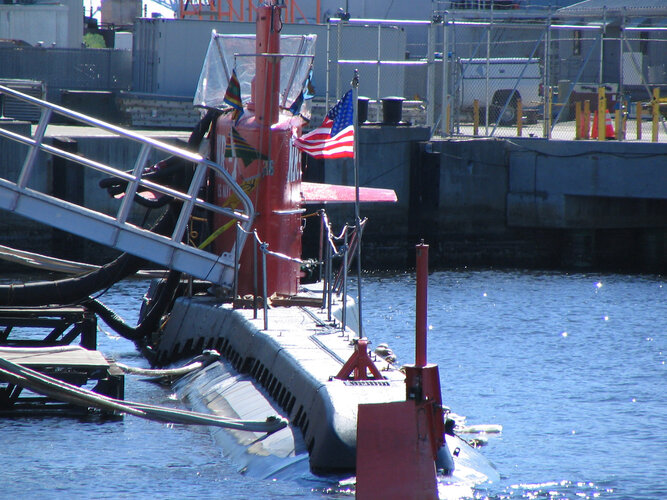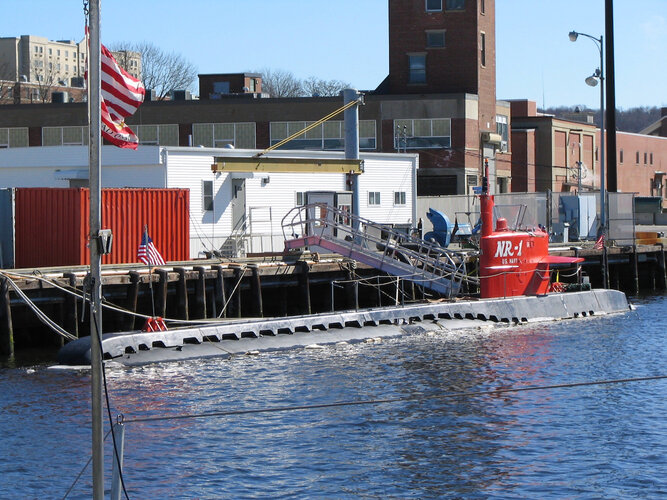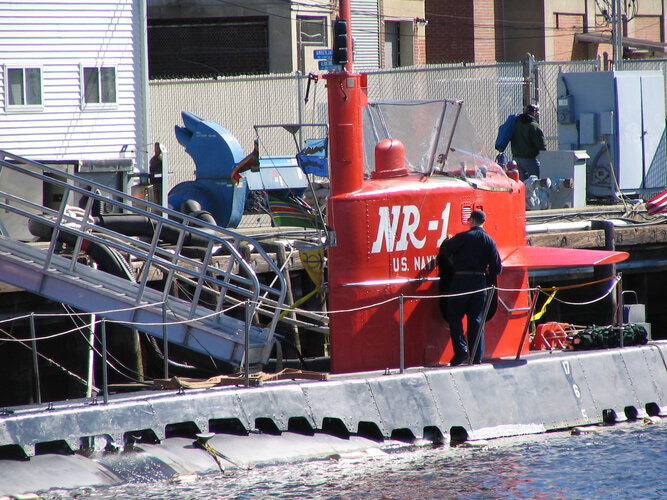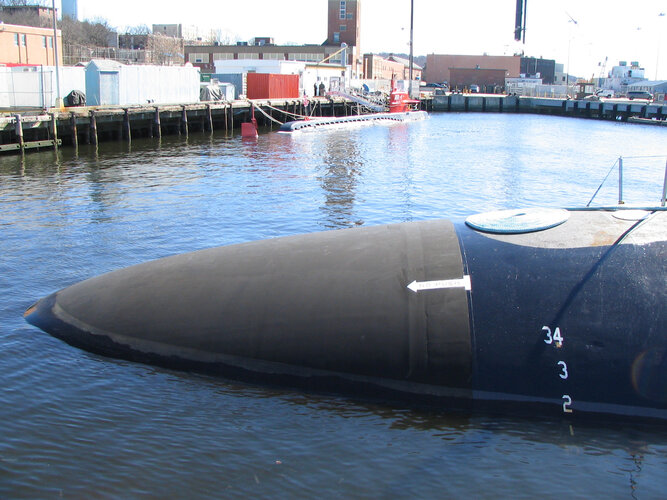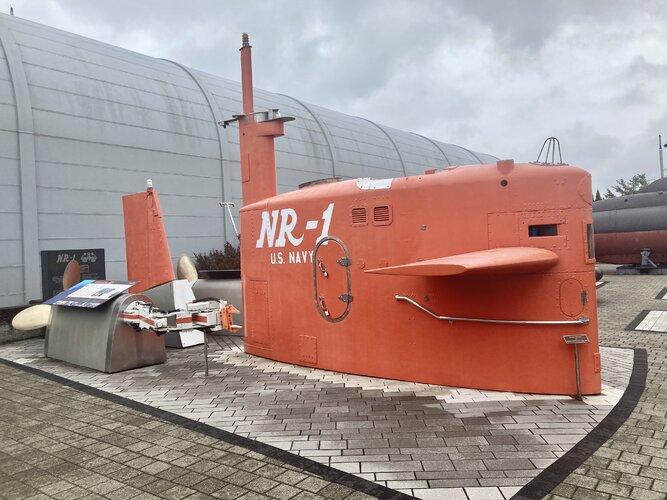You are using an out of date browser. It may not display this or other websites correctly.
You should upgrade or use an alternative browser.
You should upgrade or use an alternative browser.
is there any NR-1 replacement project ???
- Joined
- 18 March 2008
- Messages
- 3,532
- Reaction score
- 789
Not unless Rickover comes back from the grave...
NR-1 has been deactivated for over a year and since it was built there is a lot more ROV deep diving capability both civilian and military.
NR-1 has been deactivated for over a year and since it was built there is a lot more ROV deep diving capability both civilian and military.
There WAS a proposed NR-2 in the 1970s. But by then Rickover no longer had the clout that he had in the sixties, so it went nowhere.
I believe you can find some information on it in (going from memory vaguely not sure exactly what is in what).
"Dark Waters" -- Definitely information in it; except it says it was to be built with HY-100, not HY-130.
"Running Critical" -- Not Sure yet.
"Rickover" by Polmar, Pages 443-444:
I believe you can find some information on it in (going from memory vaguely not sure exactly what is in what).
"Dark Waters" -- Definitely information in it; except it says it was to be built with HY-100, not HY-130.
"Running Critical" -- Not Sure yet.
"Rickover" by Polmar, Pages 443-444:
Even as the NR-1 went to sea Rickover was laying the groundwork for the second nuclear research vehicle in his "fleet." By 1972, Rickover had the Naval Ship Systems Command officially supporting his efforts to build an NR-2. This would have the same small reactor as the NR-1, but would be built of HY-130 steel, which had at one time been intended for the Los Angeles (SSN-688) class of combat submarines, but was not ready. By using HY-130 in the NR-2, Rickover felt that the submarine could operate significantly deeper than her predecessor.
.....
In late 1976—almost simultaneously with the election of President Carter—Rickover formally asked Congress for $130 million to build the NR-2. The Navy, interested in the vehicle from the viewpoint of using the HY-130 steel, wanted the small submarine to provide important fabrication and operational information. To make this point, the Navy began referring to the NR-2 as a Hull Test Vehicle (HTV), which subsequently became its formal designation. But opponents—some in the Navy—felt that there were cheaper and easier methods of testing the steel than building a nuclear NR-2.
No NR-2—or Hull Test Vehicle—was funded by Congress either in 1976 or since then. Plans have been discussed to build such a craft in the late 1980s. American interest in deep submergence had dissipated.
- Joined
- 27 April 2008
- Messages
- 406
- Reaction score
- 126
I had thought DSRV and the later (now cancelled) ASDS were effectively the supplements and replacements to a certain degree (it was no longer neccessary to be nuclear (since you would piggy-back on a mothership), for some missions you would deploy swimmers, for manipulation - ROV's).
Here's a RAND report where they studied follow on requirements (which they term as 'NR-2', but not related to the actual NR-2 or 'HTV' as described here):
http://www.rand.org/pubs/monograph_reports/MR1395/
Here's a RAND report where they studied follow on requirements (which they term as 'NR-2', but not related to the actual NR-2 or 'HTV' as described here):
http://www.rand.org/pubs/monograph_reports/MR1395/
- Joined
- 6 November 2010
- Messages
- 4,400
- Reaction score
- 3,543
From Jane's fighting ships 1978-79:
<edit>I've read it again, and it really says "General Electric" in Jane's. Should be "General Dynamics"; only goes to show even Jane's sometimes gets it wrong.</edit>NUCLEAR POWERED RESEARCH VEHICLE: PROPOSED ("NR-2" Class)
A second nuclear-powered submersible research vehicle has been proposed by Admiral H.G. Rickover, Deputy Commander for Nuclear Propulsion, Naval Sea Systems Command. The craft would have a greater depth capability than the NR-1 [...] and would employ a nuclear plant similar to that of the earlier craft. The vehicle would have a pressure hull of HY-130 steel.
Reportedly, Admiral Rickover began development of the so-called "NR-2" in 1971. The term HTV for Hull Test Vehicle also has been used for this vehicle, reportedly to avoid critical association with the NR-1 programme.
Estimated construction time would be 2½ years; however, construction has not yet been approved. To be built of HY 130 steel reportedly at General Electric, Electric Boat Division. Unofficial estimates of construction costs ranged to more than $300 million in the Fiscal Year 1975 funding. At the beginning of 1978 construction had been stalled owing to financial problems.
- Joined
- 9 October 2009
- Messages
- 20,390
- Reaction score
- 11,115
One of the highlights of the NR-1's career: http://fly.historicwings.com/2012/09/tomcat-deep/
A very good example of why a replacement should have been proceeded with.
A very good example of why a replacement should have been proceeded with.
2IDSGT
Ah tale yew wut!
- Joined
- 27 November 2012
- Messages
- 365
- Reaction score
- 13
... and then the Soviets got access to fully-intact planes and missiles just 3 years later anyways.Grey Havoc said:One of the highlights of the NR-1's career: http://fly.historicwings.com/2012/09/tomcat-deep/
A very good example of why a replacement should have been proceeded with.
Grey Havoc said:One of the highlights of the NR-1's career: http://fly.historicwings.com/2012/09/tomcat-deep/
A very good example of why a replacement should have been proceeded with.
The NR-1 failed to recover the aircraft, and the USN resorted to a brute-force recovery using trawlers. These days, both manned and unmanned deep sea vessels are commercially available. The only extra a one-off nuclear-powered vessel would bring is endurance. Is that worth the huge cost of such a vessel?
moonbeamsts
ACCESS: Restricted
- Joined
- 5 March 2010
- Messages
- 44
- Reaction score
- 11
Greetings
From reading on the web and other sub people there is a definite need,but, budgets are stretched too thin in the near term for it to happen. Capabilities would be awesome with upgrades in equipment and habitability. I have read two limiting factors for NR-1 Food and the fact they could not pump san-tank overboard due to tank not test depth rated, It had a limit of 30 days I read. Info from past crew and book of plankowner and internet.
Jeff
exstsssbubble-head
From reading on the web and other sub people there is a definite need,but, budgets are stretched too thin in the near term for it to happen. Capabilities would be awesome with upgrades in equipment and habitability. I have read two limiting factors for NR-1 Food and the fact they could not pump san-tank overboard due to tank not test depth rated, It had a limit of 30 days I read. Info from past crew and book of plankowner and internet.
Jeff
exstsssbubble-head
- Joined
- 26 September 2008
- Messages
- 1,932
- Reaction score
- 665
2IDSGT said:... and then the Soviets got access to fully-intact planes and missiles just 3 years later anyways.Grey Havoc said:One of the highlights of the NR-1's career: http://fly.historicwings.com/2012/09/tomcat-deep/
A very good example of why a replacement should have been proceeded with.
That's what the article claims, but there's no proof. I don't think that the Soviets were allies of the Iranian revolutionaries either, and the revolutionaries definitely would not have wanted to give away a precious weapon that they needed to defend themselves. Not saying that it did not happen, but I do not think that it is obvious that it did happen.
Added an NR-1 article to Covert Shores. http://www.hisutton.com/NR-1.html






TJDougherty01
Dr. TJD
- Joined
- 30 January 2023
- Messages
- 108
- Reaction score
- 291
As noted above, the tentative plans for NR-2 never got beyond that stage. Modern UUVs can take on many of the functions that NR-1 performed in the past. Also as mentioned, Lee Vyborny's book "Dark Waters" is an excellent book on the earliest days of the NR-1 by one of the early crew members. He mentions in the book that as far as food on the NR-1, mentioned above, the crew laid in a stock of frozen TV dinners; there was a system to heat those but no other galley facilities. Also, NR-1 had a set of truck tires, filled with cement instead of air, so it could roll along the ocean bottom. Underneath is had viewports (requiring the observer to lay down) and manipulator arms. The small reactor only had lead and plastic shielding forward, to protect the crew; the water acted as the aft shield. The aft reactor and generator spaces were unmanned during operation. The reactor produced electric power via turbogenerators, which also provided power to the two electric propulsion motors. These only allowed top speeds of less than 5 knots. On one occasion, I saw it towed out by it's support ship (at that time, the Carolyn Choest) from the Sub Base down the Thames River. Usually it was towed to its operational area due to the limited self=propulsion speed.
Some photos of NR-1 I took in 2005, at the commissioning of SSN-23, and the current display of NR-1 parts at the Submarine Force Museum in Groton, CT.
Some photos of NR-1 I took in 2005, at the commissioning of SSN-23, and the current display of NR-1 parts at the Submarine Force Museum in Groton, CT.
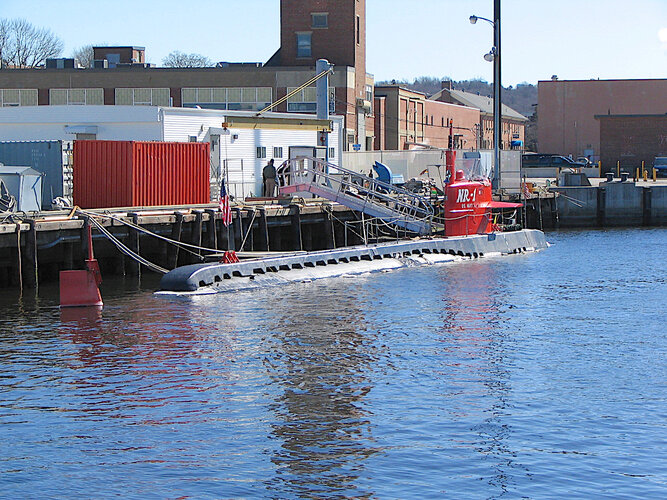
Attachments
Last edited:
southwestforests
ACCESS: Top Secret
- Joined
- 28 June 2012
- Messages
- 551
- Reaction score
- 742
Much appreciated, thank you!Some photos of NR-1 I took in 2005
Scott Kenny
ACCESS: Above Top Secret
- Joined
- 15 May 2023
- Messages
- 7,294
- Reaction score
- 6,787
There's not an easy way to make an NR-2.
NR-1 could get made because the Chairman of the Atomic Energy Commission (one Admiral Rickover) could give orders to Naval Reactors (also one Admiral Rickover), to make a small long-endurance research submersible. Because it was not armed, it did not come out of the Naval Construction Budget, or fall under any operational command's orders.
It'd take a lot more work now to make such a beast, with the AEC now the Department of Energy and not having the head of Naval Reactors as the Cabinet Secretary.
NR-1 could get made because the Chairman of the Atomic Energy Commission (one Admiral Rickover) could give orders to Naval Reactors (also one Admiral Rickover), to make a small long-endurance research submersible. Because it was not armed, it did not come out of the Naval Construction Budget, or fall under any operational command's orders.
It'd take a lot more work now to make such a beast, with the AEC now the Department of Energy and not having the head of Naval Reactors as the Cabinet Secretary.
TJDougherty01
Dr. TJD
- Joined
- 30 January 2023
- Messages
- 108
- Reaction score
- 291
Also, a lot of the tasks the NR-1 was designed for in the mid 1960's can now be accomplished with autonomous UUVs. These can be set to scan a seabed area and be controlled by sonar modem.There's not an easy way to make an NR-2.
NR-1 could get made because the Chairman of the Atomic Energy Commission (one Admiral Rickover) could give orders to Naval Reactors (also one Admiral Rickover), to make a small long-endurance research submersible. Because it was not armed, it did not come out of the Naval Construction Budget, or fall under any operational command's orders.
It'd take a lot more work now to make such a beast, with the AEC now the Department of Energy and not having the head of Naval Reactors as the Cabinet Secretary.
Scott Kenny
ACCESS: Above Top Secret
- Joined
- 15 May 2023
- Messages
- 7,294
- Reaction score
- 6,787
They can't stay down as long, but with autonomous UUVs you can use multiple of them to search an area in a few days instead of one minisub down there for a month.Also, a lot of the tasks the NR-1 was designed for in the mid 1960's can now be accomplished with autonomous UUVs. These can be set to scan a seabed area and be controlled by sonar modem.
TJDougherty01
Dr. TJD
- Joined
- 30 January 2023
- Messages
- 108
- Reaction score
- 291
And with the reduction in size of the UUVs, they are much easier to deploy and recover. Not at all like the larger towed camera and sonar bodies employed by Halibut and Seawolf (SSN 575) described in the Blind Man's Bluff bookThey can't stay down as long, but with autonomous UUVs you can use multiple of them to search an area in a few days instead of one minisub down there for a month.
Scott Kenny
ACCESS: Above Top Secret
- Joined
- 15 May 2023
- Messages
- 7,294
- Reaction score
- 6,787
I think cameras or side-scan sonar would still take a relatively large vehicle due to the range/depths of operations, but Definitely something smaller than Alvin or the DSRVs. I'm guessing something a bit bigger than a torpedo, however.And with the reduction in size of the UUVs, they are much easier to deploy and recover. Not at all like the larger towed camera and sonar bodies employed by Halibut and Seawolf (SSN 575) described in the Blind Man's Bluff book
TJDougherty01
Dr. TJD
- Joined
- 30 January 2023
- Messages
- 108
- Reaction score
- 291
Ahh, no. There are several UUVs that are either the same size or considerably smaller than a standard Mark 48 (5.8 meters-19 feet long) and 3700 lbs.
See this for an example: UUV Remus 600 and also this: Submarine launch test
Note the line in the article: The Remus 600 is a 500-pound, 3.25-meter long UUV equipped with dual-frequency side-scanning sonar technology, synthetic aperture sonar, acoustic imaging, video cameras and GPS devices, according to information from its maker, Hyrdoid.
Here's another examples with another UUV: Yellow Moray UUV
And an article on UUVs from Undersea Warfare magazine: UUV article
The Bluefin 21 is another UUV which derives the 21 designation from it's diameter, 21 inches. That is the size of the US standard torpedo tube.
Here is an older patent (2003) for a UUV recovery system through a submarine 21 inch diameter torpedo tube:UUV Recovery System Patent
See this for an example: UUV Remus 600 and also this: Submarine launch test
Note the line in the article: The Remus 600 is a 500-pound, 3.25-meter long UUV equipped with dual-frequency side-scanning sonar technology, synthetic aperture sonar, acoustic imaging, video cameras and GPS devices, according to information from its maker, Hyrdoid.
Here's another examples with another UUV: Yellow Moray UUV
And an article on UUVs from Undersea Warfare magazine: UUV article
The Bluefin 21 is another UUV which derives the 21 designation from it's diameter, 21 inches. That is the size of the US standard torpedo tube.
Here is an older patent (2003) for a UUV recovery system through a submarine 21 inch diameter torpedo tube:UUV Recovery System Patent
Last edited:
Scott Kenny
ACCESS: Above Top Secret
- Joined
- 15 May 2023
- Messages
- 7,294
- Reaction score
- 6,787
But can they go as deep as the NR-1 could?Ahh, no. There are several UUVs that are either the same size or considerably smaller than a standard Mark 48 (5.8 meters-19 feet long) and 3700 lbs.
See this for an example: UUV Remus 600 and also this: Submarine launch test
Note the line in the article: The Remus 600 is a 500-pound, 3.25-meter long UUV equipped with dual-frequency side-scanning sonar technology, synthetic aperture sonar, acoustic imaging, video cameras and GPS devices, according to information from its maker, Hyrdoid.
Here's another examples with another UUV: Yellow Moray UUV
And an article on UUVs from Undersea Warfare magazine: UUV article
The Bluefin 21 is another UUV which derives the 21 designation from it's diameter, 21 inches. That is the size of the US standard torpedo tube.
Here is an older patent (2003) for a UUV recovery system through a submarine 21 inch diameter torpedo tube:UUV Recovery System Patent
- Joined
- 16 April 2008
- Messages
- 8,725
- Reaction score
- 11,458
But can they go as deep as the NR-1 could?
Commercial pipeline survey drones can dive to 3000m, the stated max for NR1.
For example, the Exail 18D has an endurance of 24 hours and can dive to 3000m, in a package about the size of a 21-inch torp. It's been tasted for a bunch of military applications in addition to it's commercial uses.
Attachments
TJDougherty01
Dr. TJD
- Joined
- 30 January 2023
- Messages
- 108
- Reaction score
- 291
The published NR-1 test depth (probably can go 500-1000 feet deeper) is 3000 feet, not meters. This is the same test depth for the US experimental submarine SS555 Dolphin, now retired and a museum.Commercial pipeline survey drones can dive to 3000m, the stated max for NR1.
For example, the Exail 18D has an endurance of 24 hours and can dive to 3000m, in a package about the size of a 21-inch torp. It's been tasted for a bunch of military applications in addition to it's commercial uses.
The depth limit for Bluefin 21 is 4500 meters; 14,700 feet. Some UUVs have more limited depths, but as TomS has stated above, there are UUVs that can operate far deeper than the NR-1. Many of these can be deployed from existing submarine torpedo tubes. There are also large UUV programs underway, most notably Orca, which can be seen here: Orca UUV. Orca can dive to 11,000 feet.
At least part of NR-1's mission was to help with placement of hydrophone arrays for the SOSUS in the deep sound channel. The deep sound channel allows certain sound frequencies (lower frequencies) to be refracted by ocean subsurface "layers" and be detectable for 100's if not 1000's of miles. The hydrophones are laid out in straight lines orthogonal to the expected sound axis. NR-1 helped ensure proper placement of these hydrophones as well as assisting with placement and maintenance of the long array to ashore stations (NAVFACS) and the repeaters along the cable to boost the signal.
Last edited:
- Joined
- 16 April 2008
- Messages
- 8,725
- Reaction score
- 11,458
The published NR-1 test depth (probably can go 500-1000 feet deeper) is 3000 feet, not meters.
Ugh. I blame lack of caffeine.
TJDougherty01
Dr. TJD
- Joined
- 30 January 2023
- Messages
- 108
- Reaction score
- 291
been there...Ugh. I blame lack of caffeine.
Similar threads
-
-
Multi-Role Ocean Survey Ships (Royal Navy, 2020s)
- Started by Grey Havoc
- Replies: 22
-
-
Pre Enterprise and Long Beach Nuclear Surface Combatants?
- Started by Delta Force
- Replies: 45
-
Sea-based Anti-Ballastic Missile Intercept System (SABMIS)
- Started by Triton
- Replies: 69

